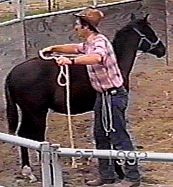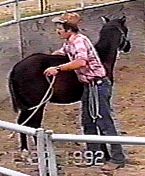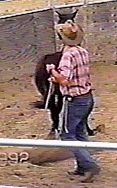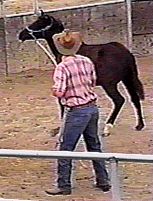|
Longe Line Logic
Part Six
|
In the previous parts we discussed getting the horse moving, drawing him and teaching him to yield in both the front end and from behind. In this part we will execute a complex maneuver which involves a combination of these skills.
Rope yields are another preparation for eventual riding. To this point we have primarily "directly" controlled the horse's motion either by drawing him toward us or having him yield from our direct pressure. The rope yield is more of an abstract draw. We will actually be cuing him to draw away from us. Properly setting up and executing the rope yields are paramount to a safe and successful maneuver.
Other horses may crowd us. While they feel the pressure coming from the
"away" side, they want to follow us as we step back to allow some space for
that rump to eventually come around. If the horse has been sufficiently
drilled in yielding, I should be able to wave him off. In such cases,
sometimes gentle tugging or light shaking of the rope will also get a horse
unlocked and moving forward and then he can yield when he takes up all the
slack in the rope and it tugs at his nose. The primary issue here is not to
get frustrated and end up frightening the horse with too much motion from
behind. If we do that the horse may move forward, but then again he might
fire at the rope. It's better to keep things calm.
Our goal at this point is to get the horse to move forward and away from us when we apply pressure to the rope, then circle calmly back to us. Through doing this maneuver he can develop his abstract skills (the human is on one side but pull is coming from the other side), get used to the bending contact coming straight back as would occur from the saddle as opposed with the longe handler bringing tension from a more lateral position, and get used to processing aids when the handler is more or less behind him and is passing from one eye to the other.
Think about the more complicated maneuvers before you attempt them. Logically work your way through the steps. If you make a mistake, don't worry about it unless it involves your or the horse's safety. Mistakes are opportunities to assess the relationship between your actions and the horse's responses to them. If the horse doesn't respond as you would expect, review how you laid out the exercise and the actions that you took. Also be sure to develop both sides of every horse. Oftentimes one side will be easy and the other side difficult. Your goal should be to have the horse working on both sides equally proficiently when you are through. Finally, effective ground schooling is preparation for safe and successful saddle work. Your ground cues can be similar to leg and rein cues from the saddle. While you may have to exaggerate your cues at first, work on refining them to the least amount of pressure necessary and shape them to be as similar to riding cues as is practical. Continue to Halters and Lead RopesReturn to Part 5Important Note: If you take on the project of developing an untrained horse, everybody will want to give you advice. Don't act on any advice, including the ideas offered in this site, unless it makes sense to you and fits your individual situation. Your abilities and the sensitivities of your horse(s) may differ from the examples given. Be alert and rational with your actions so neither you nor your horse will get hurt. This information is offered as illustrations of what we do and the reader must apply common sense since he or she is solely responsible for his or her actions. Happy trails!For related information, see "Staying a Kick Away".Continue to "Round Corral Logic".Press "Back" to return to the page that brought you hereGo to Case Study SectionReturn to Training SectionReturn to Wild Horse MentorsReturn to KBR World of Wild Horses and BurrosGo To
|




